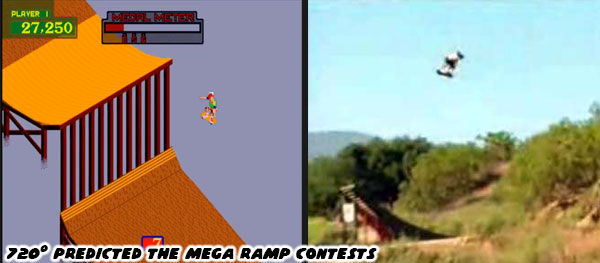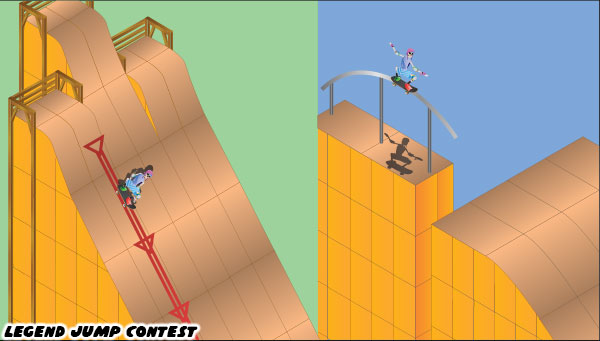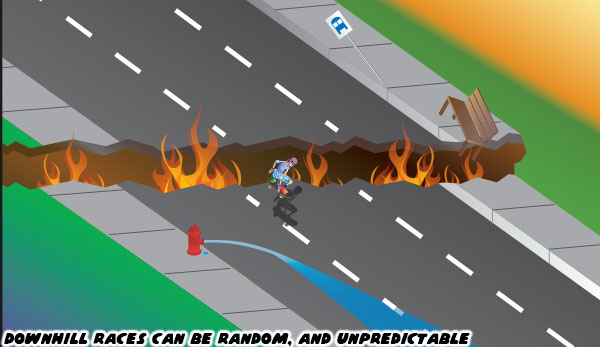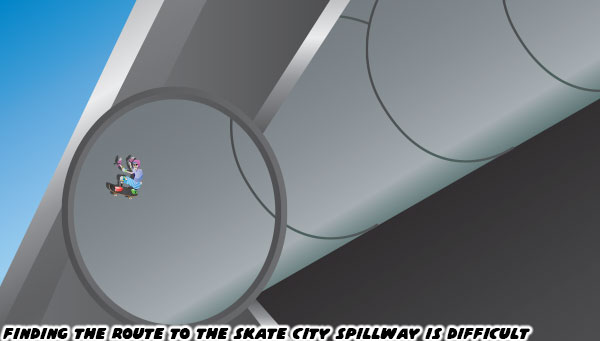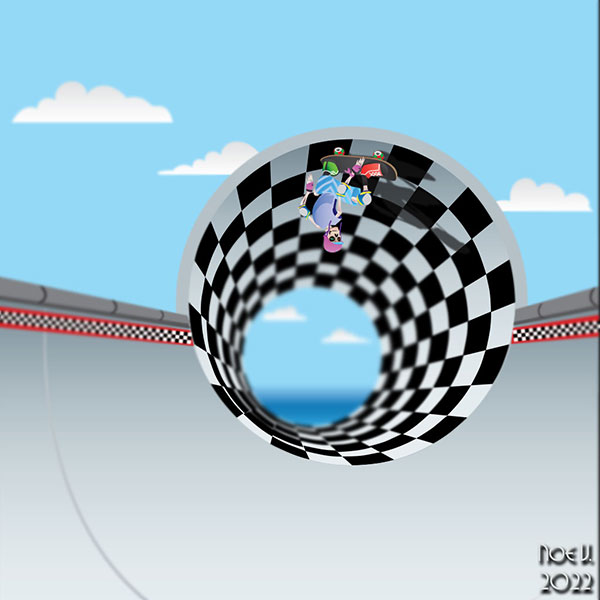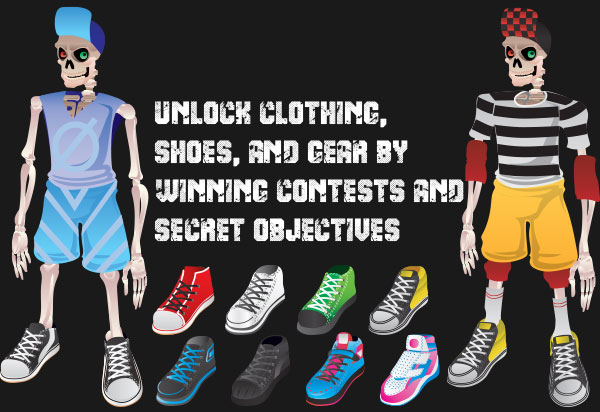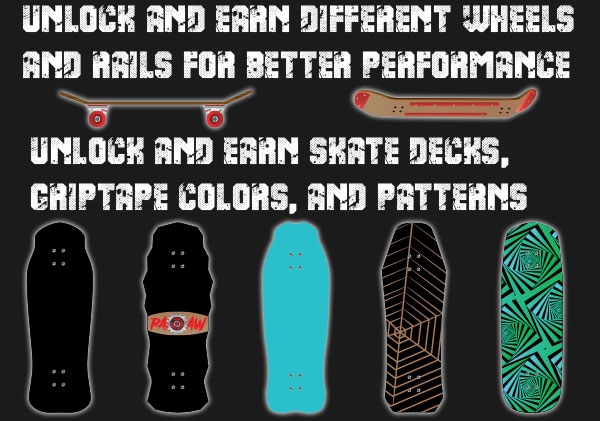
In the previous blogs I talked up how Skate City would be expanded, and feature objectives, and secrets. Also I talked a little bit about how the character can be visually customized, and how they would earn experience through the game. The character becomes better at performing tricks the more they go through the city, as well as compete. I said previously that the slalom contest would be replaced with street, and park contests. The other contests from 720° would return, but modified as well. At first glimpse fans of the original would think that the ramp contest was exactly the same as the first 720°. At least as an Amateur the first time you are invited to compete in ramp it is the original design.

The vert engine underneath the game should be completely redone. Players can now pump the transitions in order to build speed. On vert skaters are going too fast to push with their back foot, so what they do is either drop, or raise their body weight on transitions in order to build speed. It’s similar to kicking your legs out, and bringing them back in while riding a swing. Pumping was a feature of the ramp, and high air contest in Skate or Die. Not many people realize that there was an animation in the original 720° that had the character pump the transitions as well. Being able to pump is essential not only for big airs, but also to defy gravity in skateparks. Very good skaters can exploit the lines in a park, and use them to go fast enough to get inverted in full pipes, and cradles. Being able to do these things consistently would translate to higher scores in competition.

The best modern skate game to feature the pumping mechanic is the indy hit The Ramp by Paul Schnepf (@_hyperparadise). The Ramp is in an isometric view, just like 720°, and is very close to how I imagine my sequel would appear. It is an exceptional game, but I would still adjust the control, animation, and mechanics if it were to be the engine behind the 720° sequel. In The Ramp it is very easy to go off the side of the transition, especially the faster you go. The same is true for 720°. I would have the game engine “guide” players from flying off the ramp by nudging them to go straight up, and down if your character is right on the edge of the ramp. Yes the player can still shoot off the ramp if they want, but most would appreciate the nudge in the right direction so as to not lost a high score run.
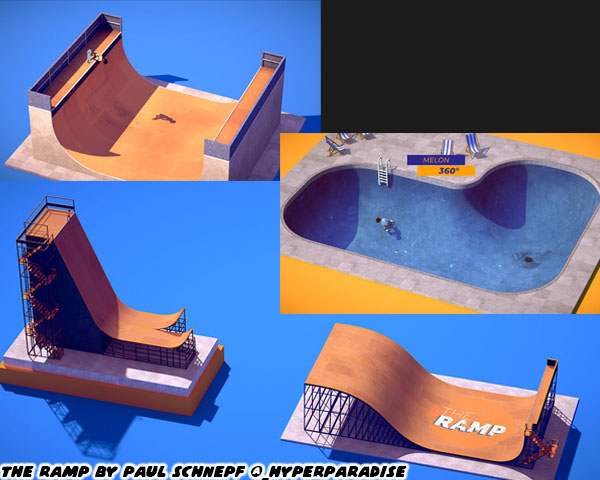
The other thing that I would add to the control scheme is the ability to rotate along all three axis (X, Y, Z). This was something that I had been pushing for Neversoft to do for years in the THPS series. The vast majority of skate games allow your character to rotate along one plane, this is the traditional frontside, or backside spin. Some games might have a special trick that a character can perform like a front flip, or a backflip. While the character is doing in this animation they cannot rotate on any other plane. A few skate games came close to allowing the full freedom of flipping, or rotating on more than one axis. Tony Hawk’s Downhill Jam, developed by Toys for Bob in 2006, allowed you to double tap a direction, and have the character flip along that axis. The animations were way over-the-top, which worked well in the context of the game. But 720° was closer to real vert tricks. Animations that looked too absurd would break the consistency of the engine.

The one game that got closest to performing these advanced tricks the way I imagine it was Grind Session by Shaba games. It debuted in March of 2000. After the original THPS, and before THPS2 was released. The game was very well done, it improved in many ways over the Neversoft hit. It introduced manuals, nose manuals, and no complies to the flatland trick library. It also allowed players to flip their board into a lip trick, which no game since has managed to accomplish. In the animation department players could string vert tricks back-to-back with seamless animation. In most skate games, including THPS 1+2, if you perform a grab trick, then another, the game engine competes the animation cycle for one trick before moving to the next one. In Grind Session the animation on the body position, hands, and feet would flow from trick to trick in one fluid motion. None of the animations would reset to the default position in between.

It was staggering how much Shaba was able to make certain skateboarding tricks work in a game format before Neversoft. I stopped calling it Grind Session, and started calling it THPS 1.5. I wasn’t the only one that saw value in what they did. The studio was bought up by Activision, and they helped port THPS3 to the Playstation, Tony Hawk’s Underground 2: Remix to the PSP, and Tony Hawk’s Project 8 to the PS2, and Xbox. Grind Session’s biggest contribution to skating engines was what they did with rotations. Some characters could perform a front flip, or back flip. The characters switched hands depending on if they were doing a front flip (Weddle grab), or back flip (Indy grab). So that they were accurate to the actual trick. While doing the flip you could actually rotate frontside or backside as well. This made the game that much more realistic, while not losing the ease of play.

You may not think that inverted spins, and flips are really possible on skateboards, but they have existed since the late ‘70s. At first they were used on lip tricks. Moves like the Elguerial, Unit, Miller Flip, and Phillips 66 were inverts that required the skater to spin, flip, and push off the coping at the same time. Then there were the aerial inversions. Skaters at that time were having difficulty figuring out how to spin 540° without losing the board. Mike McGill saw Fred Blood, a roller skater, flip into his spins, and that’s how he got the idea for the McTwist, or an inverted 540°. If you broke down the trick into its basic elements it was a backside, front flip, Weddle grab 540°. Whereas a frontside, back flip, Indy grab 540° was known as a Rodeo Flip. Skaters have performed all manner of off-axis flips, and spins for decades. It should be possible to do them in the 720° sequel. They should not be easy to perform. Rotating the front flip, or back flip is slower than a frontside, or backside spin. So a Novice, or Am wouldn’t be able to land those tricks with any consistency. When a character has the stats of a Pro then they finally have the ability land them cleanly. When a character has the stats of a Legend then they can spin, and flip with almost any grab combination, and land them with more frequency.
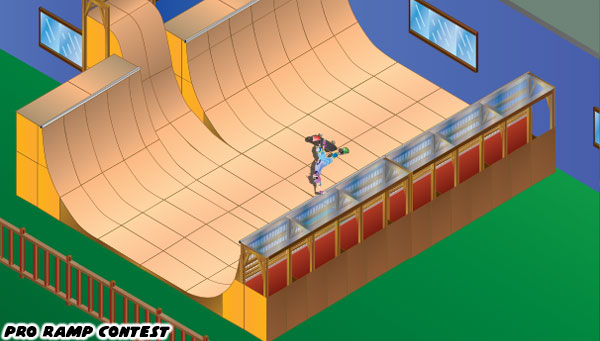
Ramp competitions are not necessarily all the same in my sequel. I mentioned that the size, and obstacles featured in street, and park contests depended on whether you were an Am, Pro, or Legend. Amateurs had the smallest courses, Pros had more space, and Legends had the biggest, and most complex courses. The same rules applied to ramp contests as well. The original 720° ramp was very simple, in my version I said it was designated for Ams. The Pro ramp has more transitions, perhaps a channel, or spine. Legend ramps are massive, they may have a hip, corner, or extension. Winning these contests require you to make full use of the ramp, while performing aerials, grinds, spin, and flip tricks.

The biggest highlight of the 720° sequel is that contests are completely randomized. I don’t mean that you end up in an Am, Pro, or Legend contest randomly, but instead that the layout, transitions, rails, and roll-ins are randomly placed. You will never end up skating the same ramp twice. This applies to park, street, or other contests. Contests also take place in different towns, so the layout, and colors of the obstacles are unique compared to those featured in Skate City. Imagine a fictional contest taking place in the South Pacific called Big Island. The player gets a hint to the location from a colorful flyer while the stage loads, then they see the park. The ramps have colors, and stickers unique to it. Each time they go back to it the ramp is completely different, yet familiar at the same time. Every contest in the game observes the same rules. Imagine how you would feel if your favorite game changed a little bit each time you played it. The game, like the art of skateboarding, should never become stale.
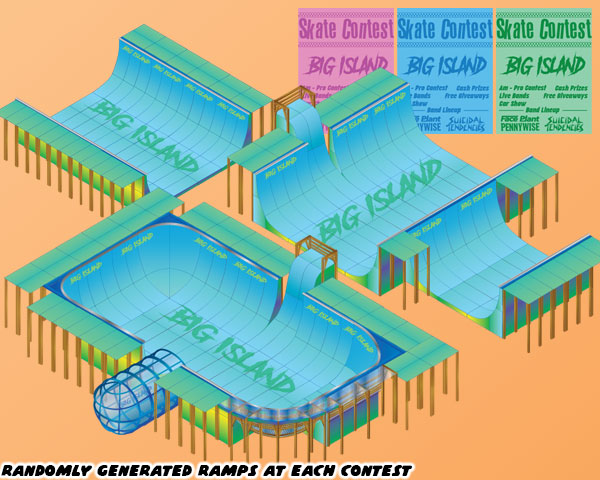
Every now, and then a ramp from skate history might pop up. For example, once, a long time ago there was a ramp in the town of Guadalupe, located between two junkyards. It was created by a legendary skater Won Ton “Animal” Chin. Long-time skate fans would recognize it from the Powell-Peralta video the Search for Animal Chin. New fans would just know that there are no random ramps that are as unique. There are a few of these ramps from the past that might have only been used for a contest, or two before being torn down by vandals, or even angry city councils. I’m on the fence as to whether or not you could save, and revisit those ramps whenever you want. Also I probably wouldn’t put in a build-a-park editor, as the game should still feel like an arcade experience.

Having the contest stages constantly evolve is possibly the most important thing the game would introduce to the genre. It goes far beyond waiting for DLC content, as the game creates its own new challenges. We certainly have the technology, and talent to make it happen. What I would do with the remaining 720° contests might be more exciting to audiences. I will talk about those in the next blog. I hope to see you back for those. Also, what do you think of my sequel idea so far? Would you play this game? If you would like to sponsor me please visit my Patreon page and consider donating each month, even as little as $1 would help make better blogs and even podcasts!





